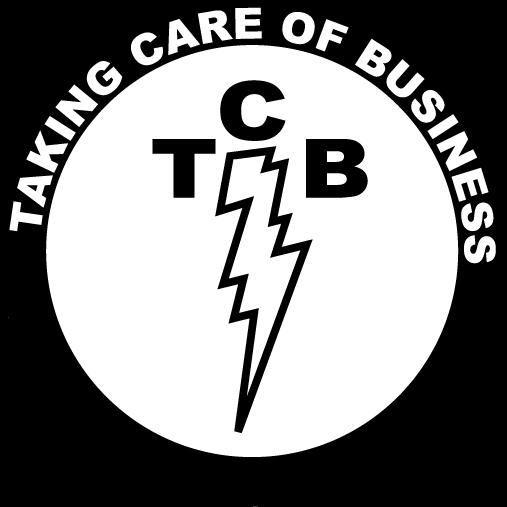


Biography
1970 - 1977
January/February 1970
Some say it is a mistake to go back to Vegas so soon, especially during the slowest season for the city. Can he fill the seats? But, Elvis returns to the International Hotel for another month-long engagement. This time he breaks his own attendance records. One-piece jumpsuits debut and karate moves are now an even bigger part of his stage show. The live album, "On Stage", is recorded in February and will be shipped in June. It will reach #13 on the album chart.
February/March 1970
A press conference in Houston on the 27th. Elvis performs afternoon and evening shows at the Houston Astrodome. Two more shows follow on the 28th. Two more follow on March 1. A closing press conference and banquet follow, and Elvis is presented an armload of recent gold record awards. The six shows attract 207,494 people and set records. There is speculation among the press and the public that Elvis might tour in concert for the first time since the fifties.
April 20,1970 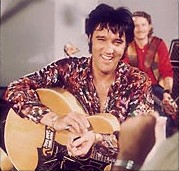
The single “The Wonder of You” is released and hits #9.
June 1970
In Nashville, Elvis records several singles and the material for the albums “Elvis Country” and “Love Letters From Elvis.”
July/September 1970
Back to Las Vegas for what the Colonel has now dubbed “The Elvis Presley Summer Festival.” This is another month-long engagement at the International. He opens on August 10 and closes on September 7. MGM is on hand to shoot a documentary film called Elvis -That’s the Way It Is that will show Elvis off stage, in rehearsals, in the recording studio, and on stage. RCA will also release an album with the same title.
September 1970
From the 9th through the 14th Elvis takes his show on a nine-city tour. It is a smashing success, the first tour since 1957, only these days the show is much more elaborate . MGM films portions of the first show on this tour for use in Elvis - That’s the Way It Is. 
Elvis has a recording session in Nashville to finish up the albums started in June.
October 9, 1970
Elvis buys his first Stutz Blackhawk, a 1971 model.
October 19, 1970
Picks up the first order of 12 TCB necklaces from Schwartz and Ableser Jewelers in Beverly Hills.
November 11, 1970
Elvis, hat’s the Way It IsT, Elvis thirty-second film, opens in theaters to good reviews and good box office. Documentaries traditionally do not do well at the box office, but this one makes a respectable showing. It, like other Elvis movies will go on to have a life on television and home video in years to come. An album of the same title is released, but only one song, I Just Can't Help Believin', is actually from a stage performance included in the film. The other songs are studio recordings, some of which Elvis performs live on stage or in rehearsal footage in the film. The album peaks at #21 on the album chart.
Elvis does a successful eight-city concert tour.
December 4, 1970
December 4, 1970, Elvis and Priscilla complete the purchase of another home in California at 144 Monovale for $339,000
December 21, 1970
Elvis’ famous visit with President Richard Nixon at the White House occurs and today copies of the photos from that meeting are the most requested documents from our National Archives..
January 16, 1971
Elvis attends a day of functions culminating in an evening awards banquet. He and nine others accept the honor of being named One of the Ten Outstanding Young Men of the Nation by the United States Junior Chamber of Commerce (The Jaycees). He is nervous about his acceptance speech. He is touched, excited and deeply proud. This national honor has been given each year since the late 1930’s and recognizes young men who have made great achievements in their field of endeavor, illustrating the opportunities available in the free enterprise system. It also applauds humanitarianism and community service. Scientists, inventors, performers, film makers, politicians bound for the Presidency, and men of greatness in all fields, have been selected for this award over the years. For Elvis, a man who grew up poor, and, in his early career knew the sting of ridicule from the Establishment, who, through the years has known criticism of his work, this is one of his proudest moments. It is a sign that he has achieved acceptance, recognition, and respect for his work and for the kind of person he is. During this Las Vegas engagement, “Also Spach Zarusthra” commonly known as the theme from the movie 2001:A Space Odyssey will be played in the middle of the show as a break for Elvis.
Late January/February 1971
Elvis plays another month-long engagement at the International Hotel in Las Vegas.
March 1971
Elvis begins a recording session in Nashville, but cancels it due to pain and inflammation in an eye. He is treated at a Nashville hospital where he is diagnosed with secondary glaucoma. This eye condition will plague him from time to time in varying degrees for the rest of his life.
May 1971
Elvis is featured on the cover of Look Magazine, which carries an installment of the forthcoming biography on Elvis by Jerry Hopkins. Many books and articles have been written over the years, but this is the first in-depth, serious biography. The book Elvis : A Biography will be released in October.
Elvis has recording sessions in Nashville. Much of the work is for his forthcoming album Elvis Sings the Wonderful World of Christmas.
June 1971
The two-room house Elvis was born in opens to the public for tours, having been restored by the East Heights Garden Club in Tupelo. Elvis has more recording sessions in Nashville, this time mostly for an upcoming gospel album, He Touched Me.
A long stretch of Highway 51 South, part of which runs in front of Graceland, is officially renamed Elvis Presley Boulevard. The first of the new street signs will go up in January of 1972.
Various albums and singles continue to be released to various degrees of success during this period.
July/August 1971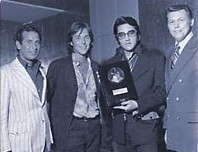
Elvis plays a two-week engagement at the Sahara Hotel in Lake Tahoe, Nevada. With this first appearance at the Sahara Tahoe, “2001” will now be Elvis’s entrance theme for his concert shows. He breaks attendance records for this venue.
August 9 - September 6, 1971
Elvis plays an engagement in Las Vegas at the International Hotel, which has been renamed the Las Vegas Hilton International Hotel. He sets another attendance record and tops himself once again.
During the engagement an award is presented to Elvis in his dressing room. It is the Bing Crosby Award from the National Academy of Recording Arts and Sciences (the organization that also presents Grammy awards). This award is a special means of recognition from NARAS and is named for its first recipient. The award is not given every year as a rule. It will later be re-named the Lifetime Achievement Award. Elvis is 36 years old.
On August 28, 1971 Elvis received the Lifetime award.
November 5-12, 1971
Elvis goes on a 12-city concert tour. J.D. Sumner and the Stamps Quartet have now replaced the Imperials and Jackie Kahane is now the opening comedienne. Elvis now wears matching capes with his jumpsuits.
Late 1971, Early 1972
Elvis and Priscilla separate. She moves out on her own with Lisa Marie.
January 26 - February 23, 1972
Elvis plays another successful engagement at the Hilton in Vegas. 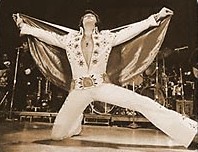
March/April 1972
In April MGM films Elvis in a Hollywood recording studio, then films on and off stage during his 15-city concert tour, which is a big success. MGM will use the footage for another theatrically released documentary, Elvis on Tour.
In April the gospel album He Touched Me is released to good reviews. The album will go on to win Elvis his second Grammy Award, this one for the category of Best Inspirational Performance.
June 1972
Elvis continues touring in concert, beginning with a press conference in New York on the 9th. MGM is on hand to film the conference for use in Elvis on Tour. Elvis makes entertainment history by performing four sold-out shows at New York’s Madison Square Garden. John Lennon, George Harrison, Bob Dylan, David Bowie, and Art Garfunkel are among the music stars spotted at the shows.
Nine days after it is recorded, RCA rush-releases a live album from one of the shows - Elvis as Recorded at Madison Square Garden. Elvis tours to seven more cities.
Elvis' Vegas and concert tour career is hot, hot, hot during the early to mid-seventies. He breaks attendance records in cities all over America. Record releases also continue.
July 26, 1972
Elvis and Priscilla’s separation is formalized. A divorce is to come. Elvis has begun seeing Linda Thompson, who will be his main female companion until late 1976.

August 4 - September 4, 1972
Elvis plays a month-long engagement at the Hilton in Vegas.
September 4, 1972
Elvis participates in a press conference, between the dinner and midnight shows, in Vegas announcing plans for a television concert to be broadcast via satellite around the world from Hawaii. It is predicted that the show will reach the largest audience in television history and that the live album will be a big hit.
October 1972
Elvis has a number two pop hit with the single Burning Love, one of his biggest records in recent years.
November 1972
Elvis on Tour opens to good reviews and good box office performance in theaters. Later, its producers will receive the Golden Globe Award for Best Documentary of 1972. Like other Elvis films it will have a life on television and on home video.
Elvis tours seven cities in concert. The last is Honolulu, Hawaii, where he does three shows at the Honolulu International Center Arena, the same venue that will host his satellite special in January.
November 20, 1972
Elvis appears at a press conference in Hawaii regarding his upcoming satellite show. It is announced that it will be a benefit for the Kui Lee Cancer Fund.
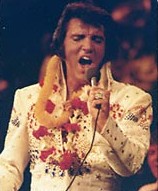
January 1973
Elvis makes television and entertainment history with his Elvis: Aloha from Hawaii - Via Satellite special. Performed at the Honolulu International Center Arena on January 14, 1973, broadcast live at 12:30 AM Hawaiian time, beamed via Globecam Satellite to Australia, South Korea, Japan, Thailand, the Phillipines, South Vietnam and other countries. It is seen on a delayed basis in around thirty European countries. A tape of the show will be seen in America on April 4th on NBC. The live broadcast in January attracts 37.8% of the viewers in Japan, 91.8% in the Philippines, 70% in Hong Kong, and 70-80% of the viewers in Korea. The April showing in America will attract 51% of the television viewing audience, and will be seen in more American households than man’s first walk on the moon. In all, it will be seen in about forty countries by one billion to 1.5 billion people. Elvis commissions an American Eagle design for his jumpsuit for this show, his patriotic message to his worldwide audience.* Never has one performer held the world’s attention in such a way. Elvis is in top form physically and vocally. This is probably the pinnacle of his superstardom, one of the all-time great moments of his career.
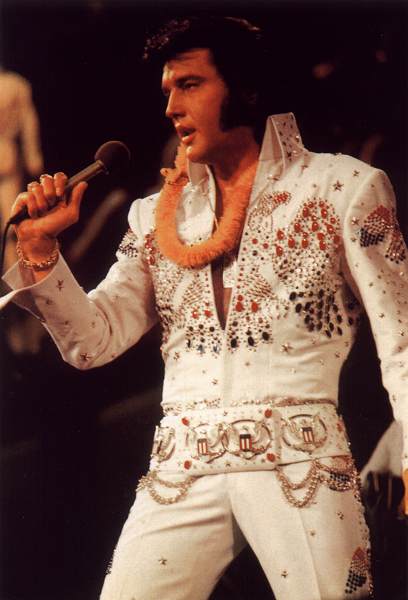 Audience tickets for the January 14 concert and its January 12 pre-broadcast rehearsal show carry no price. Each audience member is asked to pay whatever he or she can. The performances and concert merchandise sales are a benefit raising $75,000 for the Kui Lee Cancer Fund in Hawaii. (Kui Lee was a Hawaiian composer who had died of cancer while still in his thirties.)
Audience tickets for the January 14 concert and its January 12 pre-broadcast rehearsal show carry no price. Each audience member is asked to pay whatever he or she can. The performances and concert merchandise sales are a benefit raising $75,000 for the Kui Lee Cancer Fund in Hawaii. (Kui Lee was a Hawaiian composer who had died of cancer while still in his thirties.)
On stage with Elvis is an orchestra and his current show cast: Joe Guercio (conductor), J.D. Sumner & the Stamps (vocals), The Sweet Inspirations (vocals), Kathy Westmoreland (soprano vocals), Charlie Hodge (guitar/vocals/on-stage assistance), James Burton (lead guitar), John Wilkinson (rhythm guitar), Jerry Scheff (bass guitar), Glen D. Hardin (piano), and Ronnie Tutt (drums).
The soundtrack album is soon released and goes to number one on the Billboard pop album chart, and stays on the chart at various positions for 52 weeks. The show will later have continued life on television and eventually home video.
In the special, Elvis' recording of the theme song from his 1965 movie Paradise, Hawaiian Style plays over the opening credits and scenes of Elvis' helicopter arrival at the airport and his walking among the fans who are there to greet him. The concert opens with Elvis' band playing his traditional introduction for his seventies concerts, Theme from 2001. He sings See, See Rider, Burning Love, Something, You Gave Me a Mountain, Steamroller Blues, My Way, Love Me, Johnny B. Goode, It’s Over, Blue Suede Shoes, I’m So Lonesome I Could Cry, I Can’t Stop Loving You, Hound Dog, What Now, My Love, Fever, Welcome to My World, Suspicious Minds, I’ll Remember You (A Kui Lee composition Elvis sings after announcing the sum raised for the Kui Lee Cancer Fund.), Long Tall Sally/Whole Lotta Shakin’ Goin’ On, An 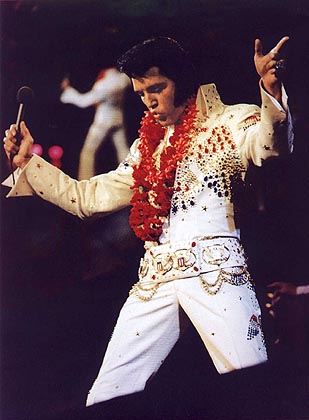 American Trilogy (Elvis tosses his belt into the audience), A Big Hunk o’ Love, and Can’t Help Falling in Love (Elvis tosses his cape into the audience). The show is one hour, including commercials. After the show, Elvis and his bandmates come back out on stage in the empty arena and videotape performances of the songs Blue Hawaii, Ku-u-i-po, and Hawaiian Wedding Song which he had first done for his 1961 hit movie, Blue Hawaii, plus Early Morning Rain and No More. All but the song No More will be inserted into the American broadcast with Elvis seen on a montage screen with footage of Hawaiian scenery.
American Trilogy (Elvis tosses his belt into the audience), A Big Hunk o’ Love, and Can’t Help Falling in Love (Elvis tosses his cape into the audience). The show is one hour, including commercials. After the show, Elvis and his bandmates come back out on stage in the empty arena and videotape performances of the songs Blue Hawaii, Ku-u-i-po, and Hawaiian Wedding Song which he had first done for his 1961 hit movie, Blue Hawaii, plus Early Morning Rain and No More. All but the song No More will be inserted into the American broadcast with Elvis seen on a montage screen with footage of Hawaiian scenery.
A Little History on Elvis' Costume: Elvis told Bill Belew he wanted the jumpsuit for this special to say “America” to the worldwide viewing audience. Bill told Elvis that, except for the American flag, he could think of nothing other than the American Eagle. Elvis said “I like it.” And that’s how one of Elvis' most famous costumes came to be. Elvis had been wearing jumpsuits on stage since 1970, and they had become quite elaborate by the time of this show. For the past year or two he had been wearing studded, hip-length capes and heavy studded leather belts with his jumpsuits. For the American Eagle jumpsuit, Bill first designed a huge calf-length cape. During preparations for the show, Elvis tried working with this cape, but it was just too cumbersome to use. So, out went the emergency order for another cape in the usual size.
January 26 - February 23, 1973
Elvis plays an engagement at the Las Vegas Hilton.
January 28, 1973
Elvis On Tour co-wins a Golden Globe Award with Walls of Fire as best feature documentary of 1972.
February 1973
In Las Vegas, Elvis presents boxer Muhammad Ali with a specially made robe for Ali’s upcoming title fight with Joe Bugner. Ali would gift Elvis with autographed boxing gloves.
March 1, 1973
Elvis and Col. Parker sell Elvis’s music rights to date, to RCA and Elvis enters into a new seven-year recording contract with RCA. Elvis and Col. Parker sign a new management contract as well, becoming 50 – 50 partners.
April 4, 1973
The Aloha special is seen on American television for the first time and garners 57% of the viewing audience.
April 19, 1973
Elvis’ paternal grandfather Jessie Presley dies of a heart attack in Louisville.
Late April 1973
Elvis goes on an eight-city concert tour.
May 4-16, 1973
Elvis plays an engagement at the Sahara Hotel in Lake Tahoe, Nevada. 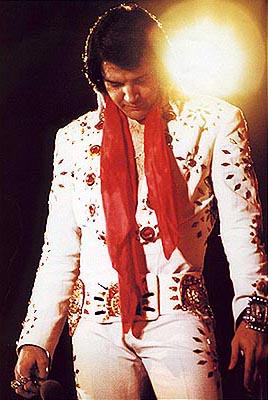
May 1973
The Aloha from Hawaii concert album hits number one on the Billboard pop album chart. It is his first number one album since Roustabout soundtrack album in 1965. It will also be his last number one album on the pop chart.
June 20 - July 3, 1973
Elvis goes out on concert tour.
July, 1973
Elvis records a few songs at the Stax Recording Studio in Memphis for the album "Raised on Rock" at Stax Recording Studio in Memphis. This was his first time to record in Memphis since 1969.
August 6 - September 3, 1973
Back to the Vegas Hilton for another engagement.
October 9, 1973
Elvis and Priscilla make a court appearance together and their divorce is granted. They will continue to be close friends. Though Elvis and Priscilla have joint custody of Lisa Marie, there will be no formal schedule of visitation for Elvis, and he and his daughter will spend time together regularly.
October 15 - November 1, 1973
Girlfriend Linda thompson is by Elvis' side while he is hospitalized in Memphis for recurring pneumonia and pleurisy, an enlarged colon, and hepatitis. Elvis has been battling health problems for some time, including an increasing dependency upon prescription drugs. It will get worse. He also battles his weight.
December 1973
Elvis returns to the Stax Recording Studio in Memphis for a week of sessions. He records the albums "Promised Land" and "Good Times".
January 26-February 9, 1974
Elvis plays the Vegas Hilton again.
March - July 1974
Elvis is on tour through much of March. In March he returns to the Houston Astrodome and sets a one-day attendance record with his two shows. Also in March he plays Memphis for the first time since 1961 and does four shows on March 16 & 17 to meet the demand for tickets. Another live album results from the excitement in Memphis, and on March 20, Elvis Recorded Live On Stage in Memphis, recorded at one of the shows. Included is a live performance of How Great Thou Art that will go on to win Elvis his third Grammy award. He resumes touring in May and plays the Sahara in Lake Tahoe May 16 -26. He’s back on tour in mid-June and takes a few weeks off, starting in early July.
Graceland’s den is being redecorated into its present Polynesian décor, and Elvis is working on the script to the movie “The New Gladiators.”
August 19 - September 2, 1974
Back to the Hilton in Vegas for an engagement. Elvis talks on stage about karate.
September 27 - October 14, 1974
Elvis is on tour again. Plays the Sahara-Tahoe October 11-14. 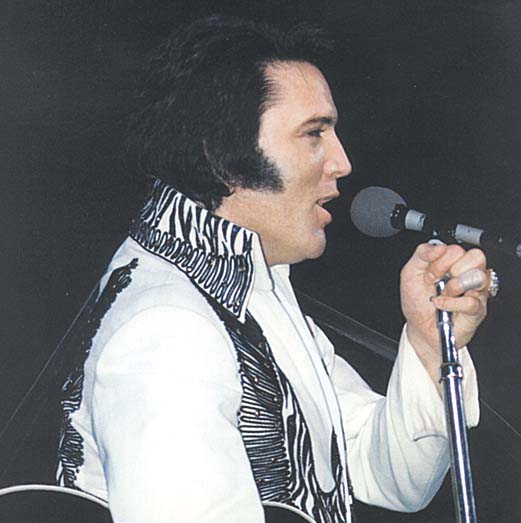
Record releases have continued through this period with varying degrees of success.
January 29 - February 14, 1975
Elvis is hospitalized with health and prescription problems again. Vernon has heart attack and father and son have adjoining rooms in the hospital.
March 1, 1975
Elvis’ live recording of "How Great Thou Art" from the album recorded at one of his Memphis concerts on March 20, 1974 wins the Grammy for Best Inspirational Performance. This is Elvis’ third and final Grammy win out of fourteen nominations (one nomination posthumously). All three Grammy wins have been for his gospel music.
March 10 - 12, 1975
Elvis records material for the “Today” album at RCA Sunset Blvd. Studio.
March 18 - April 1, 1975
Engagement at the Hilton. On March 28, 1975 Barbra Streisand talks to Elvis about “Star Is Born.” A formal offer will be made on April 4, 1975 and the Colonel responds with a counter offer for Elvis’s services on the 14th, which was subsequently rejected.
April 17, 1975
Elvis purchases a Convair 880 jet and renames it the “Lisa Marie.”
April - July, 1975
Elvis tours in concert.
August 18 - September 5, 1975
Elvis opens in Vegas but ends his engagement on the 20th and is hospitalized in Memphis until September 5. 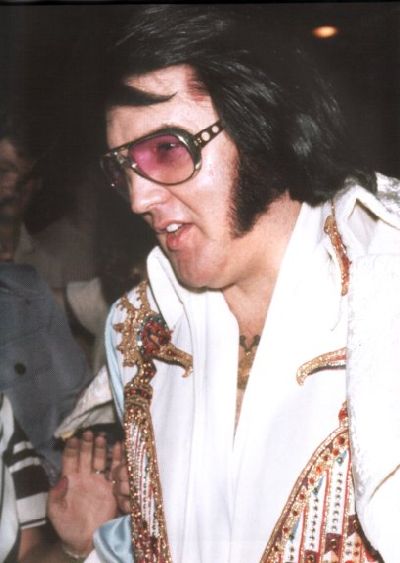
November 11, 1975
The renovation of a Convair 880 jet Elvis bought earlier in the year is complete, and he takes his first flight on the Lisa Marie jet.
December 2-15, 1975
Elvis returns to the Hilton in Vegas to make up for the shows that were canceled during his previous engagement.
December 31, 1975
Elvis performs a special New Year’s Eve concert in Pontiac, Michigan and sets a single performance attendance record of 62,500.
February 1976
Elvis has a week of recording sessions in the den at Graceland, with RCA bringing in mobile recording equipment. Songs from this will comprise the forthcoming album From Elvis Presley Boulevard, Memphis, Tennessee (which will hit number one on the country album chart in May) and over half of the forthcoming Moody Blue album.
March 17-22, 1976
Elvis tours in concert.
April 21-27, 1976
Elvis tours in concert.
April 30 - May 9, 1976
An engagement at the Sahara Tahoe in Nevada.
May 27- June 6, 1976
Elvis tours in concert.
June 25 - July 5, 1976
Elvis tours in concert.
July 23 - August 5, 1976
Elvis tours in concert.
August 27-September 8, 1976
Elvis tours in concert.
October 14-27, 1976
Elvis tours in concert.
October 29-30, 1976
Continuation of recording in the den at Graceland, and Elvis records his last single "Way down." 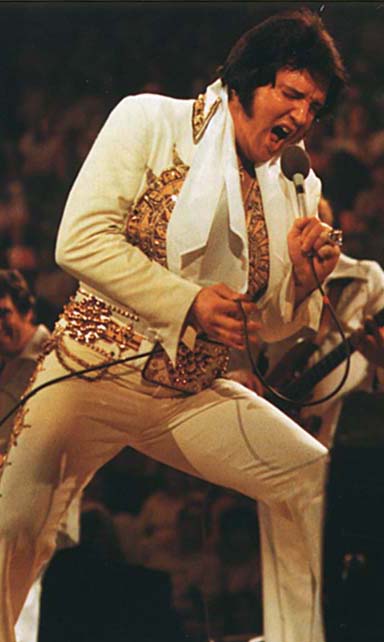
Early November, 1976
Elvis and Linda Thompson, his steady girlfriend since 1972, split up.
November 19, 1976
Elvis meets Ginger Alden who will be his steady girlfriend until his death.
November 24-30, 1976
Elvis tours in concert.
December 2-12, 1976
Elvis plays the Hilton in Vegas for what will turn out to be the last time.
Evangelist Rex Humbard and his wife visit Elvis’s show and meet with him backstage on December 12, 1976. Humbard will be asked to speak at Elvis’s funeral the next year.
December 27-31, 1976
Elvis tours in concert, ending with a special New Year’s Eve concert in Pittsburgh, Pennsylvania.
February 12-21, 1977
Elvis tours in concert.
March 3-13, 1977
Elvis and his friends enjoy a vacation in Hawaii.
March 23-30, 1977
Elvis tours in concert.
April 1-5, 1977
Elvis is hospitalized in Memphis and tour shows scheduled for March 31-April 3 are canceled.
April 21- May 31/June 1-2, 1977
Elvis tours in concert.
June 1977
The single “Way Down” is released and will peak at #18.
June 17-26, 1977
Elvis tours in concert. Shows on June 19, 20, and 21 are recorded by RCA for an upcoming live album and are videotaped for an upcoming CBS-TV television special. (Footage from the show on the 20th is not used in the special.) The special will be called Elvis in Concert. It will first air on October 3 after Elvis’ death in August. The camera gives a shocking picture of Elvis’ poor health in his final days, but his voice is strong.
June 26, 1977
A concert at Indianapolis, Indiana’s Market Square Arena. This will turn out to be his very last concert performance. 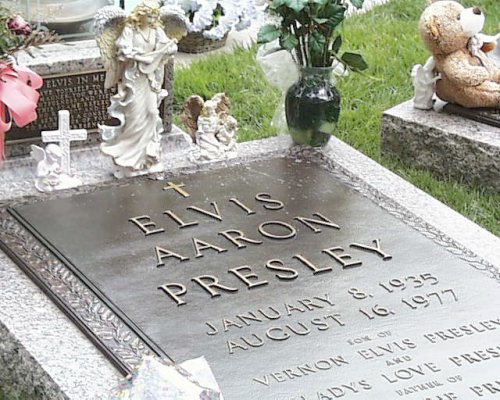
June 27- August 15, 1977
Elvis relaxes in Memphis and prepares for the next leg of touring for 1977.
July 1977
The album “Moody Blue” will be released and after his death it will hit #3 selling more than two million copies.
August 16, 1977
Shortly after midnight Elvis returns to Graceland from a late-night visit to the dentist. Through the early morning of the 16th he takes care of last minute tour details and relaxes with family and staff. He is to fly to Portland, Maine that night and do a show there on the 17th, then continue the scheduled tour. He retires to his master suite at Graceland around 7:00 AM to rest for his evening flight. By late morning, Elvis Presley is dead of heart failure. It is announced by mid-afternoon. In a matter of hours the shock registers around the world.
August 18, 1977
Funeral
October 2, 1977
Bodies moved to Graceland
October 3, 1977
CBS special “Elvis In Concert” airs. The album is also released and peaks at #5 quickly selling 1.5 million copies.
This site is best viewed at 1024x768 pixels









 Audience tickets for the January 14 concert and its January 12 pre-broadcast rehearsal show carry no price. Each audience member is asked to pay whatever he or she can. The performances and concert merchandise sales are a benefit raising $75,000 for the Kui Lee Cancer Fund in Hawaii. (Kui Lee was a Hawaiian composer who had died of cancer while still in his thirties.)
Audience tickets for the January 14 concert and its January 12 pre-broadcast rehearsal show carry no price. Each audience member is asked to pay whatever he or she can. The performances and concert merchandise sales are a benefit raising $75,000 for the Kui Lee Cancer Fund in Hawaii. (Kui Lee was a Hawaiian composer who had died of cancer while still in his thirties.)  American Trilogy (Elvis tosses his belt into the audience), A Big Hunk o’ Love, and Can’t Help Falling in Love (Elvis tosses his cape into the audience). The show is one hour, including commercials. After the show, Elvis and his bandmates come back out on stage in the empty arena and videotape performances of the songs Blue Hawaii, Ku-u-i-po, and Hawaiian Wedding Song which he had first done for his 1961 hit movie, Blue Hawaii, plus Early Morning Rain and No More. All but the song No More will be inserted into the American broadcast with Elvis seen on a montage screen with footage of Hawaiian scenery.
American Trilogy (Elvis tosses his belt into the audience), A Big Hunk o’ Love, and Can’t Help Falling in Love (Elvis tosses his cape into the audience). The show is one hour, including commercials. After the show, Elvis and his bandmates come back out on stage in the empty arena and videotape performances of the songs Blue Hawaii, Ku-u-i-po, and Hawaiian Wedding Song which he had first done for his 1961 hit movie, Blue Hawaii, plus Early Morning Rain and No More. All but the song No More will be inserted into the American broadcast with Elvis seen on a montage screen with footage of Hawaiian scenery. 



